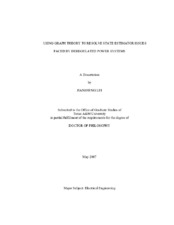| dc.description.abstract | Power industry is undergoing a transition from the traditional regulated environment
to the competitive power market. To have a reliable state estimator (SE) in the power
market environment, two major challenges are emerging, i.e. to keep SE running reliably
even under a contingency and to run SE over a grid with extremely large size.
The objective of this dissertation is to use graph theory to address the above two
challenges.
To keep SE running reliably under a contingency, a novel topological approach is
first proposed to identify critical measurements and examine network observability
under a contingency. To advance the classical topological observability analysis, a new
concept of contingency observability graph (COG) is introduced and it is proven that a
power system network maintains its observability under a contingency if and only if its
COG satisfies some conditions. As an application of COG, a two-stage heuristic
topological approach is further developed based on the new concept of qualified COG
(QCOG) to minimize the number of measurements and RTUs under the constraint that
the system remains observable under any single contingency.
To overcome the disadvantages of existing SE over extremely large networks, a
textured distributed state estimator (DSE), which consists of the off-line textured
architecture design and the on-line textured computation, is proposed based on COG and
a new concept of Bus Credibility Index (BCI). The textured DSE is non-recursive,
asynchronous and avoids central controlling node. Numerical tests verify that the performance of the new textured DSE algorithm improves greatly compared with
existing DSE algorithms in respect of bad data detection and identification. Furthermore,
the software implementation for DSE is formulated as an information integration
problem over regional power markets, and is very challenging because of its size and
complexity. A new concept of semantic knowledge warehouse (SKW), together with the
proposed concepts of semantic reasoning software component (SRSC) and deduction
credibility, is developed to implement such an information integration system. | en |


